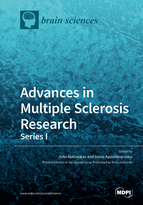Advances in Multiple Sclerosis Research—Series I
A special issue of Brain Sciences (ISSN 2076-3425).
Deadline for manuscript submissions: closed (30 June 2020) | Viewed by 80513
Special Issue Editors
Interests: medicinal chemistry; autoimmunity; NMR; modelling; organic chemistry
Special Issues, Collections and Topics in MDPI journals
Interests: cancer; autoimmunity; mental health; vaccines; exercise
Special Issues, Collections and Topics in MDPI journals
Special Issue Information
Dear Colleagues,
Designing immunotherapeutics, drugs, and anti-inflammatory reagents has been at the forefront of autoimmune research, in particular multiple sclerosis, for over 20 years. Delivery methods that are used to modulate effective and long-lasting immune responses have been the major focus. This Special Issue will focus on delivery methods to be used for vaccines, immunotherapeutic approaches, drug design, and anti-inflammatories and their outcomes in preclinical studies and clinical trials.
Prof. Dr. John Matsoukas
Prof. Dr. Vasso Apostolopoulos
Guest Editors
Manuscript Submission Information
Manuscripts should be submitted online at www.mdpi.com by registering and logging in to this website. Once you are registered, click here to go to the submission form. Manuscripts can be submitted until the deadline. All submissions that pass pre-check are peer-reviewed. Accepted papers will be published continuously in the journal (as soon as accepted) and will be listed together on the special issue website. Research articles, review articles as well as short communications are invited. For planned papers, a title and short abstract (about 100 words) can be sent to the Editorial Office for announcement on this website.
Submitted manuscripts should not have been published previously, nor be under consideration for publication elsewhere (except conference proceedings papers). All manuscripts are thoroughly refereed through a single-blind peer-review process. A guide for authors and other relevant information for submission of manuscripts is available on the Instructions for Authors page. Brain Sciences is an international peer-reviewed open access monthly journal published by MDPI.
Please visit the Instructions for Authors page before submitting a manuscript. The Article Processing Charge (APC) for publication in this open access journal is 2200 CHF (Swiss Francs). Submitted papers should be well formatted and use good English. Authors may use MDPI's English editing service prior to publication or during author revisions.
Keywords
- vaccines
- immunotherapeutics
- anti-inflammatory
- drug design
- peptides
- peptide mimetics
- altered peptide ligands
- pre-clinical studies
- clinical trials
- antibodies
- delivery methods
- dendritic cells
- particulate vaccines
- adjuvants
- peptide-based vaccines
- DNA vaccines
- T cell responses
- regulatory T cells
- tolerance
- clinical outcomes
- antigen processing
- antigen presentation
- MHC-T cell interaction








